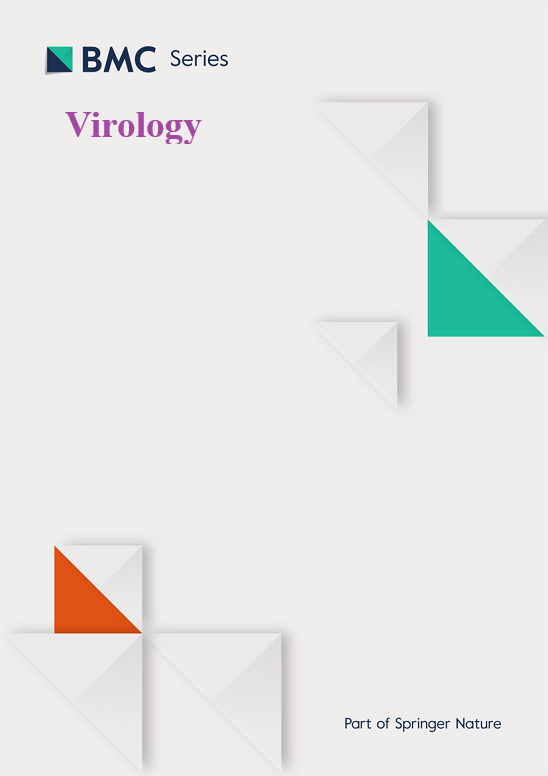2021 - 2023年四川省鸡传染性支气管炎病毒GI-19显性基因型频繁参与重组事件
IF 2.8
3区 医学
Q3 VIROLOGY
引用次数: 0
摘要
传染性支气管炎病毒(IBV)是鸡传染性支气管炎(IB)的病原,是一种高度传染性的呼吸道疾病,对全球家禽业造成了重大的经济负担。全面了解IBV的流行病学模式和遗传变异对于制定有效的预防和控制战略至关重要。在这项研究中,我们在2021年至2023年期间从四川省收集了684份疑似样本。PCR检测总阳性率为26.9%,其中广元地区阳性率最高,为37.2%。随后,我们获得了21个完整的IBV S1基因序列,系统发育分析确定GI-19型为优势菌株。比较21株分离菌株的核酸相似度,核苷酸相似度为66.48% ~ 99.69%(氨基酸相似度为56.22% ~ 99.45%)。QXL87疫苗株与分离株具有较高的相似性。GVI型菌株与QXL87在HVR I中的氨基酸组成不同,导致S1基因上n -糖基化位点减少。此外,与QXL87疫苗株相比,所有分离株均显示S1基因上n -糖基化位点的不同减少。最终,重组分析显示GI-19和GI-22菌株经常参与基因重组。大多数重组菌株来源于GI-19菌株的部分片段,所有分离的GI-19菌株均未观察到重组。综上所述,本研究结果阐明了四川省IBV的流行情况,强调了GI-19菌株在IBV重组中的关键作用,为IBV的控制提供了有价值的数据支持。本文章由计算机程序翻译,如有差异,请以英文原文为准。
The GI-19 dominant genotype of infectious bronchitis virus in chickens from 2021 to 2023 in Sichuan province is frequently involved in recombination events
Infectious bronchitis virus (IBV), the etiological agent of infectious bronchitis (IB) in chickens, is a highly contagious respiratory disease that poses significant economic burdens on the global poultry industry. Comprehensive knowledge of the epidemiological patterns and genetic variations of IBV is crucial for effective prevention and control strategies. In this study, we collected 684 suspected samples from Sichuan province between 2021 and 2023. PCR testing revealed a total positivity rate of 26.9 %, with the Guangyuan region exhibiting the highest positivity rate at 37.2 %. Subsequently, we obtained 21 complete IBV S1 gene sequences and the phylogenetic analysis identified the GI-19 type as the predominant strain. Comparing nucleic acid similarity among the 21 isolated strains, we observed a range of 66.48 %–99.69 % nucleotide similarity (56.22 %–99.45 % in amino acids). The QXL87 vaccine strain exhibited higher similarity to the isolated strains. Amino acid variations in the three hypervariable regions (HVRs) showed the highest variability in HVR I. The GVI type strain differed in amino acid composition from QXL87 in HVR I, resulting in reduced N-glycosylation sites on the S1 gene. Furthermore, all isolated strains displayed varying reductions in N-glycosylation sites on the S1 gene compared to the QXL87 vaccine strain. Ultimately, recombination analysis revealed frequent involvement of the GI-19 and GI-22 strains in gene recombination. The majority of recombined strains were derived from partial segments of the GI-19 strain, with no recombination observed in any of the isolated GI-19 strains. In summary, our findings elucidate the prevalence of IBV in Sichuan province and highlight the pivotal role of the GI-19 strain in IBV recombination, thereby offering valuable data support for IBV control.
求助全文
通过发布文献求助,成功后即可免费获取论文全文。
去求助
来源期刊

Virology
医学-病毒学
CiteScore
6.00
自引率
0.00%
发文量
157
审稿时长
50 days
期刊介绍:
Launched in 1955, Virology is a broad and inclusive journal that welcomes submissions on all aspects of virology including plant, animal, microbial and human viruses. The journal publishes basic research as well as pre-clinical and clinical studies of vaccines, anti-viral drugs and their development, anti-viral therapies, and computational studies of virus infections. Any submission that is of broad interest to the community of virologists/vaccinologists and reporting scientifically accurate and valuable research will be considered for publication, including negative findings and multidisciplinary work.Virology is open to reviews, research manuscripts, short communication, registered reports as well as follow-up manuscripts.
 求助内容:
求助内容: 应助结果提醒方式:
应助结果提醒方式:


